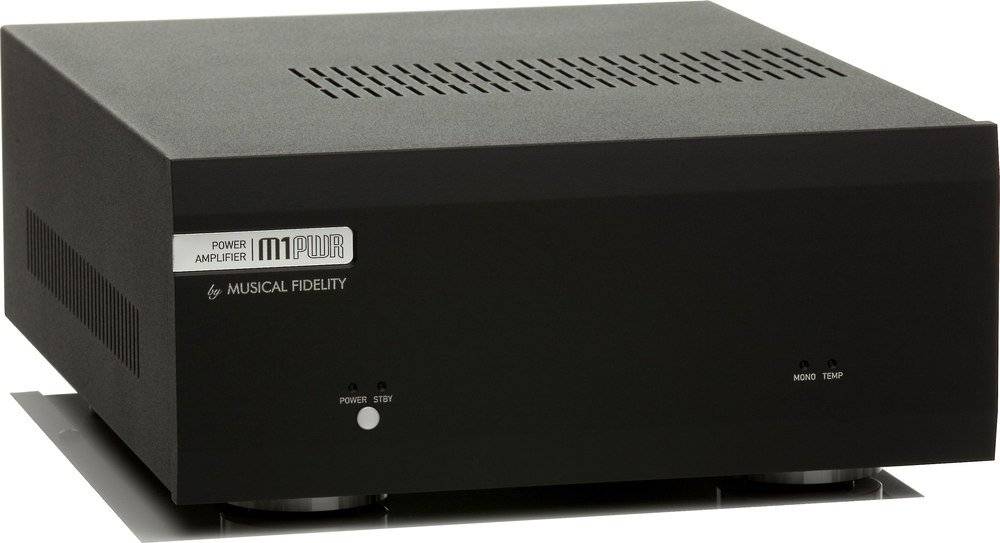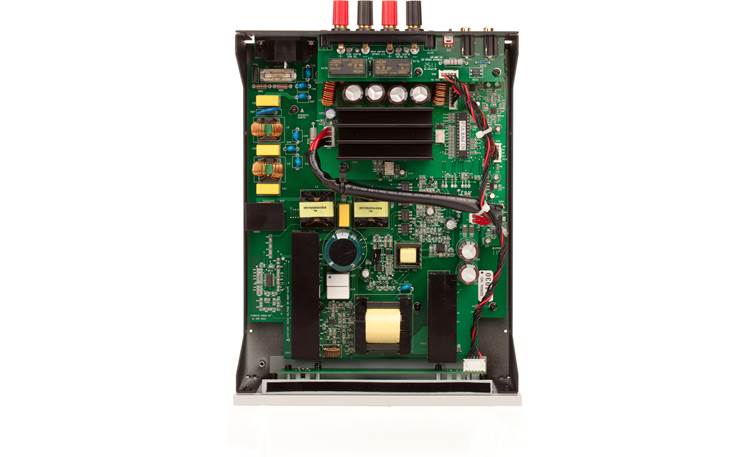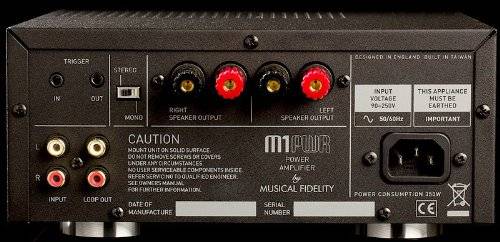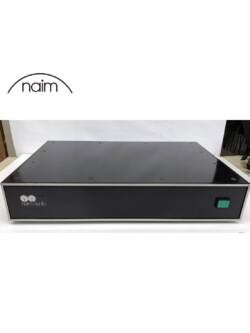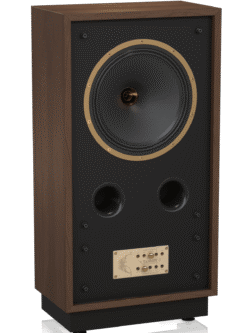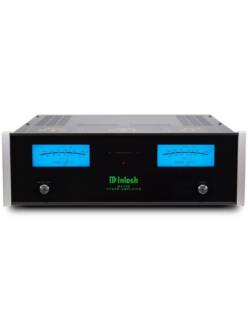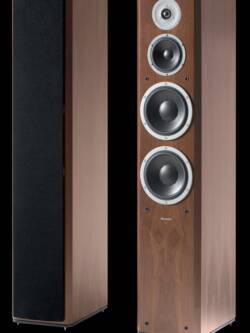Music Fidelity M1 PWR Monoblocks (x2)
Original price was: R32,000.00.R15,000.00Current price is: R15,000.00.
- Power output: Stereo Mode 65W into 8Ω, 130W into 4Ω, Mono Mode 100W into 8Ω, 200W into 4Ω
- THD(+ noise): Stereo <0.03%, Mono <0.02%
- Signal to Noise Ratio: Stereo >94dB, Mono >100dB.
- Frequency Response: <0.5dB, (20Hz to 20kHz)
Description
The Musical Fidelity M1PWR is a high-efficiency stereo power amplifier. It stands out because of its much smaller size and lower power consumption compared to other amplifiers with the same power output.
It’s only about half as wide as most amplifiers, and about as tall and and as deep. It has a 100W Mono mode, so you could get two and put them side-by-side in about the same space as just one 60 watt per channel amplifier.
It is a class-D switching amplifier. Musical Fidelity also makes plenty of class AB and class A amplifiers if you prefer, but class D is the future. In fact, most consumer audio amplifiers are already class D, and if you’ve been to any amplified live concert, concert sound amplifiers have been class D for about a decade for the same reasons: you can pack a huge amount of power in a small space in an amplifier small enough for one man to lift, and they don’t get hot.
If you’ve been to a recording studio in the past ten years, their monitors have also become “active,” with low-level crossover and amplifiers built into the speakers themselves, and most of these amplifiers are also class D, again for the same reasons: more power, less weight and less heat. (Passive speakers with separate amplifiers went away 10 or 20 years ago professionally.)
My house lights never blink when I turn on the M1PWR from the power inrush typical of class AB amplifiers. There’s never a voltage drop that kicks-in the battery backup of my uninterruptible power supply that happens with my big class AB amplifiers! With this M1PWR, tapping the POWER button simply turns on my music with no surges and no headaches.
There is no delayed muting on power-on or Standby; it comes up almost instantly, and keeps playing for several seconds if you yank the power cord. If you tap Standby, it quiets quickly. If you pull the power while in Standby, the yellow standby light stays on quite a while.
For its small size, it’s heavier than you’d expect if it were only a preamp. It has a nice thick aluminum front plate and nice rubber feet on the bottom. It is a slightly weird size, just wider than 1/2 of a standard 17″ (430mm) A/V component. The rest of the case is reasonably sturdy sheet metal. There are no ventilation holes to let in dirt and dust over the years.
A nice surprise are loop-through outputs. If you want to send the same signal to another component, there is a second pair of RCA jacks direct-connected to the input so you can daisy-chain the input signal anyplace else you like.
The rear speaker connecters pleasantly accept standard 3/4″ spaced banana plugs, but have an odd design where the entire top half of the jack and its inner conductor rotate together, screwing as one in and out of the jack’s base. This means that there is no way to poke a tinned lead or test probe through the base of the center conductor.
Musical Fidelity M1PWR Speaker Connectors. The threaded part rotates with the ribbed plastic parts.
Specifications top
Intro Specifications Sound Measurements Usage Recommendations
Circuit Design
High frequency switching power supply, which allows a much smaller power transformer.
Class D switching amplifier, which greatly increases efficiency and eliminates the need for big heat sinks.
Bridged outputs, even in regular stereo mode.
Output Power
Stereo
65 watts per channel into 8Ω.
130 watts per channel into 4 Ω.
Mono (one channel only)
100 watts into 8Ω.
200 watts into 4 Ω.
Frequency Response
<0.5 dB, 20 – 20,000 Hz.
Crosstalk
85 dB, stereo.
Signal to Noise Ratio
Stereo
>94 dB, A-weighted.
Mono (one channel only)
>100 dB, A-weighted.
THD
Stereo: 0.03%, 20 – 20,000 Hz.
Mono: 0.02%, 20 – 20,000 Hz.
Audio Input
One stereo pair of 1/4″ RCA jacks, with a passive loop-through output (total 4 jacks).
Audio Output Connectors
4-way binding posts.
The insulators hold the inner conductors captive, and the whole top half rotates as screwed in or out.
I call these 4-way instead of 5-way because they have a bizarre design devoid of the fixed center conductor, so there is no lateral through-hole into which to poke a bare wire or test probe.
Standard 3/4″ jack spacing for banana plugs.
Remote Power Control (trigger input and output)
3.5mm mono jack.
±4.5 to ±15 VDC input.
+12 VDC output.
Power Input
Universal: 90-250 VAC, 50-60 Hz.
Rated 350 W maximum.
Actual power consumption is much less.
Quality
Made in Taiwan.
Size
100 x 220 x 315 mm, HWD.
3.94 x 8.66 x 12.40 inches, HWD.
Depth includes connectors and switches.
Height includes feet.
Weight
8.6 pounds (3.9 kg), or 10.14 pounds (4.6 kg) for the complete system packed in its carton, rated.
8.7 lbs. (3.94 kg) actual measured.
Included
M1PWR.
Power cord.
Instruction booklet and other paperwork.
Announced
10 January 2012.
Price, USA
$500, August-September 2013.
$1,300, Jan 2012 – July 2013.
Sound top
Intro Specifications Sound Measurements Usage Recommendations
The M1PWR is a tiny bit bright, and all the music is there. In fact, it is so detailed that I thought I heard the amplifier add some spurious idle tones during a quiet section in my favorite recording of The Planets (track 5, 4:11), but on further listen, I was hearing someone’s cell phone ringing from a mile away that I had not heard before in that recording!
The M1PWR has highly detailed sound with clear transients. If you want more detail than you’re getting with your current amp, this could be your answer.
Auditioned on an exceptionally high resolution and wide-band system, once I knocked-off a half or a whole dB with my treble control, voilà, I got perfect tonal balance. Once the treble is lowered to taste, it’s smooth and clean. Everything sounds as it should, from the top down all the down to infrasonics. I use full-size (B&W 801) loudspeakers near-field and full-range (equalized flat down to 16 Hz), with no need for subwoofers. I’m listening to real music with many instruments playing at once (not audiophile drivel), so I’m hitting the amplifier with a whole lot of music at one time and able to hear whatever it’s doing right or wrong without the room acoustics muddying it.
The M1PWR is a little harsher on massed strings and background noise. Sometimes I can imagine it sounding a little like a noise gate; it’s less convincing on noise fields (something which is part of the natural ambience of most classical recordings) than my traditional class AB amplifiers.
Likewise, musical subsonics are good, but not quite as good as I get with my favorite power-hog class AB amplifier. Not to worry, almost no one reading this has speakers that can reproduce 32 Hz, much less 16 Hz, well or at all. This most likely has to do with the 1 dB loss at 20 Hz.
Sound stage is super wide, but maybe not quite as deep as with my class AB amplifier.
Swapping between ON and Standby modes, there aren’t any significant transients.
It is normal that there’s a slight acoustical hissing or whirring sound from the amplifier’s power supply while in standby. It goes away when on.
There will be some slightly audible hiss from your speakers if you hold your head about 12-18″ away when no music is playing. This amplifier has a poorer signal to noise ratio than most other amplifiers.
That’s all one half of 1% of the sound. Otherwise, it sounds exactly as it should. Amplifiers, cables and DACs are the very least important sonic elements of any sound reproduction system. It’s far better to put an extra $3,000 into your speakers, room acoustic treatments and music collection than to spend any more of a limited budget on amplifiers.
Measurements top
Intro Specifications Sound Measurements Usage Recommendations
Gain Channel Balance Power Output Distortion LEDs
Damping Factors Noise SNR RFI DC Offset
Frequency Response THD SINAD DFD
These measurements were made with a $50,000 Rohde & Schwarz UPL laboratory analyzer. The traces from the Rohde & Schwarz UPL laboratory analyzer are color coded for the Left Channel and for the Right Channel. When they don’t lie on top of each other, it’s due to channel imbalance. When they do lie on top of each other, the trace turns blue.
Unless otherwise specified, all measurements are made at 1 watt output per channel into 8 Ω.
Gain measurements top
29.57 dB left, 29.51 dB right, 8Ω load (29.70 db/29.65 dB unloaded).
For 1 W into 8Ω, input is 94 mV at 1 kc.
Channel Balance measurements top
The channels are about 0.05 dB off, which is perfect enough.
Power Output measurements top
Stereo
Per channel, both channels driven to 0.1% THD into 8Ω at 120 ±0.2 VAC supply:
60 watts from 20-2,000 Hz.
I use 0.1% THD as my criteria because that’s the smallest amount of clipping THD I can hear under ideal conditions (headphones) on sine waves.
Because the M1PWR’s THD climbs with frequency, at higher frequencies it can’t keep the distortion below 0.1% at most power levels. It can only put out this much power at higher frequencies and keep THD below 0.1%:
45 watts at 5 kc.
3.7 watts at 6.3 kc.
2.9 watts at 8 kc.
2.4 watts at 10 kc.
1 watt at 20 kc.
Of course if you allow for more THD, it puts out much more power.
If we allow it 0.2% THD, it puts out 65 watts at 1 kc.
If we allow it 10% THD, which is about where most people would start to hear something obviously wrong on musical peaks, it puts out 97 watts per channel into 8Ω.
Instantaneous peak power at the point of visible clipping on an oscilloscope for 10 cycle (10ms) bursts at 1 kc is 75 watts RMS, which is about the same as above. Clipping is less visible on a scope than is 0.1% THD, so there really isn’t any more burst power than there is continuous power.
Mono
One channel to 0.1% THD at 120 ±0.2 VAC power input:
84.9 watts into 8Ω. (861.4mV audio input.)
167.4 watts into 4Ω. (863.7mV audio input.)
The yellow STBY LED blinks if you play it too loudly and cause distortion.
I saw the LED turn on at 73 watts continuous sine wave into 8Ω, at which point there was 0.4% THD.
This is a perfect point at which to light the LED, but sadly the LED is tiny and blinks unpredictably, so it’s not much of an indictor. Personally, I’d use big red xenon strobe tubes to alert us of clips.
If you short the output, the blue light blinks and nothing comes out. It is a bridged output, so if any of the four speaker connectors come in contact with ground or any other speaker connection, you’ve got a short circuit.
Damping Factors measurements top
|
Left
|
Right
|
|
|
50 cps
|
62
|
63
|
|
1 kc
|
61
|
64
|
|
20 kc
|
13.9
|
13.9
|
Damping factor is fine at most frequencies, but gets worse at high frequencies, most likely due to a passive low-pass filter at the switched amplifier’s output.
Output Noise measurements top
You’ll hear a slight hiss if you get closer than a foot or two to most speakers in a silent room. Here are the numbers:
|
Measurement bandwidth
|
Unweighted
|
A Weighted
|
|
22 kc
|
-68 dBV
|
-71.4 dBV
|
|
80 kc*
|
-60.9 dBV
|
|
|
110 kc
|
-58 dBV
|
-71 dBV
|
|
700 kc*
|
-40 dBV
|
Measured with R&S UPL, * are measured with Panasonic VP-7721A, which has a 700 kc RMS measurement bandwidth. A-weighting ignores almost everything above 20 kc, so it will read the about same regardless of analyzer bandwidth.
Signal to Noise Ratio (SNR) measurements top
80.4 dB A-weighted SNR (13.1 effective bits) referred to 1 watt into 8Ω (2.83V or +9.031 dBV), 22 kHz bandwidth.
Conducted and Radiated Emissions measurements top
Since this is a switching amplifier, square waves are oscillating at hundreds of kiloHertz inside, with lots of amplitude. This means that RF (radio frequencies) are going to get out of the box. I used to specialize in EMI (electromagnetic interference) certifications for the US military, where we measured all this in great detail to ensure that things didn’t interfere with each other — and every time we saw high-frequency switching power supplies, we know we’d have plenty of work to do.
For fun, I took a Sony all-band receiver and listened in the longwave (150-500 kc) band, and lo and behold, I heard carriers even in the standby mode (the M1 PWR is never off).
In standby, I heard modulated carriers at 154, 192, 387 and 427 kc.
With the power ON, I heard carriers at 192, 282, 300, 378 and 474 kc.
I heard different carrier frequencies on different days. I don’t know if these are radiating from the box, or the speaker leads.
I got even more curious, and played music into a dummy-load resistor, and I kid you not, I heard my music playing at 405 kHz AM!
This is to be expected; this amplifier most likely is using pulse-width modulated high-power square waves. If you really want to get out, use a long enough wire as an antenna, and void your warranty and go in and bypass the low-pass filters — but don’t ever plug it into speakers if you do because you’ll probably torch your tweeters instantly!
Output DC Offset measurements top
57.8 mV left, 11.8 mV right.
Frequency Response measurements top
Frequency response does not vary with power output level, which is good.
M1PWR ultrasonic frequency response into 8Ω, 1,000 – 110,000 Hz.
Aha! A peak of 2/3 of a dB at 39 kc, most likely a byproduct of a passive output low-pass filter.
Measured on the Panasonic VP-7221A, it’s down about 16 dB at 120 kc, down 19.5dB at 130 kc, down 22dB at 140 kc, down 24 dB at 150 kc and down about 26 dB at 160 kc.
That’s driving an 8Ω resistor, which doesn’t count in the real world. Let’s see what it does with other output loads:
M1PWR frequency response into no load (top), 8Ω (middle) and 4Ω (bottom). With 8 Ω at 1 kHz as reference, you can see how the output gain varies with load due to the finite damping factor.
Hmm, the high frequency response varies with output load. This is what we’d expect due to the low damping factor (higher output source impedance) at high frequencies.
Let’s look out to 110 kc and see more:
SINAD measurements top
As a switching amplifier, the M1PWR puts out lots more noise than do linear amplifiers in the ultrasonic range.
Measuring THD + Noise in a 700 kHz bandwidth with the Panasonic VP-7721A, THD+N will measure about 0.7% at 1 watt into 8Ω and 1.5% at 100 mW, due to the higher levels of ultrasonic noise.
THD+N doesn’t vary with signal frequency. It’s 0.7% in a 700 kc bandwidth at 1W from 20 – 20,000 cps, and of course if the measurements are restricted to the audio band, much, much less.
I measured this to be sure I wasn’t going to fry any tweeters before plugging this into my B&W 801s.
This is a lot of DFD. The good news is that we’re not going to hear the spikes close-in to the carriers, and the nastier 1 kc component that we might hear is as low as other amplifiers. Again, this amplifier measures well for what’s musically significant.
Measured Power Consumption measurements top
Here’s the real reason to own the M1PWR: it draws very little power, only about whatever your speakers need.
It draws about 12.5 watts when on but not playing, so it only barely gets a little warm in one spot on the case, and playing loud enough to wake the saints, it won’t get any warmer.
Compared to a big hot beast like my favorite ADCOM GFA-555 II, the M1PWR uses almost no power and dissipates no heat.
At 1 WPC output (2W total), the M1PWR draws less than 15 W, while the beastly GFA-555 II draws 92 W under exactly the same conditions.
At 120VAC ±0.2 VAC, stereo output into 8Ω, unless noted as mono or 4Ω:
|
Condition
|
Power Consumption
|
Efficiency
|
|
Standby (orange light)
|
0.45 W (0.04 A)
|
0%
|
|
Idle (blue light, no signal)
|
12.6 W (0.16 A)
|
0%
|
|
1 WPC output (2 W total)
|
14.8 W (0.18 A)
|
13.5%
|
|
10 WPC output (20 W total)
|
32.5 W (0.33 A)
|
61.5%
|
|
60 WPC (120 W total; 735mV in)
|
158 W (1.33 A)
|
75.9%
|
|
65 WPC (130 W total)
|
168 W (1.43 A)
|
77.4%
|
|
84.9 W mono
|
115 W (0.99A)
|
73.8%
|
|
167.4 W mono 4Ω
|
214 W (1.8 A)
|
87.6%
|
Usage top
Intro Specifications Sound Measurements Usage Recommendations
There is no power switch; it is always either in Standby (yellow LED lit), or ON after you press the nice metal POWER button (blue LED lit).
There is no OFF position. A blue or yellow LED will always be lit if it’s plugged into the wall.
You can’t just plug it into a power strip and have it come on with the rest of your system; it will stay in Standby until you hit the POWER button or trigger it from a DC trigger signal as part of a larger system.
It also has a trigger output when you turn it on, so you could conceivably control the rest of your system from the power switch on the M1PWR.
I wish there was a rear-panel option to have it default to ON when power is applied, but there isn’t. It only wakes up in the Standby mode.
The outputs are bridged, meaning don’t connect any terminal to ground or any other speaker connection or you’ll have a short circuit.
If the POWER LED blinks in blue, the outputs are shorted.
Never, even take the cover off this amplifier You’ll void your warranty.
The MONO – STEREO switch doesn’t have audio going through it. It won’t do anything if you move it while playing music. Its position is only read when you turn on the M1PWR, and the M1PWR then bases what it does on where it read the position of the switch. To change the operation of the amp, move the switch and then turn it back on.
There is no dedicated clip indicator, but the tiny STBY LED will blip a little in yellow if you’re clipping.
Recommendations top
Intro Specifications Sound Measurements Usage Recommendations
The M1PWR excels for first-class power amplification when size, weight and power consumption matter. Not only will you save a little on your power bill, in the summer you’ll also save a little on your cooling bill.
The M1PWR excels where power consumption, size, weight or heat loading is important. If you’re running on solar power on your yacht, need a first-class high fidelity system in your aircraft or want to improve on the dinky amplifiers in your whole-house remote-controlled audio system, the M1PWR is your amplifier.
Personally I see use for this amp in my office, where my class AB amplifiers heat up my office and demand too much air conditioning. My wife hates it when our whole house is chilled to 64ºF just so my working office is bearably cool with all my equipment running.
I also see it as ideal to power our backyard system, where I won’t feel guilty leaving the M1PWR on 24/7 so I can play into it from our whole-house or AirPort Express system.
Heck, for those who appreciate fine motorcars, power consumption is low enough that you easily can power this from a DC power inverter, and run them in your automobile.
If you need the absolute best-sounding amplifier for a reference system, I slightly prefer the sound of my huge traditional ADCOM GFA-555 II, and Musical Fidelity of course makes many fine class AB and class A amplifiers, like the Musical Fidelity M6 500i (500 WPC integrated) for a few thousand dollars, the M8700M (700WPC dual-mono) for $12,500 or their best AMS100 100W class A dual mono amplifier for a mere $20,000.
With this M1PWR on sale today, you get 99% of the sound of a $20,000 amplifier for less than 3% of the price. Yes, I can hear a few fractions of a percent difference from perfection with this M1PWR as part of an unusually high-resolution and ultra wideband system, but it’s highly unlikely that anyone else will hear anything amiss, and many may prefer the slightly added brightness, detail and improved transient response.
The M1PWR is the least expensive amplifier from a company used to making five-figure amplifiers. The M1PWR sounds marvelous as part of an exacting reference system, especially if you prefer more detail.
Enjoy! I just saved you $19,500 — and the M1PWR is even styled similar to the AMS100.
If you find the time I invested researching and sharing this review, this free website’s biggest support is when you use any of these links to get anything, and especially this link to the M1PWR at Amazon if you get some for yourself.
